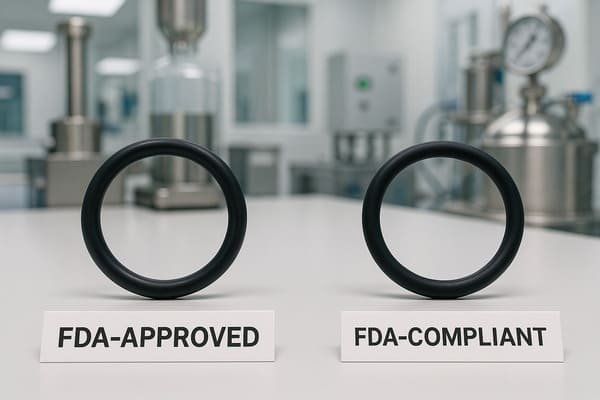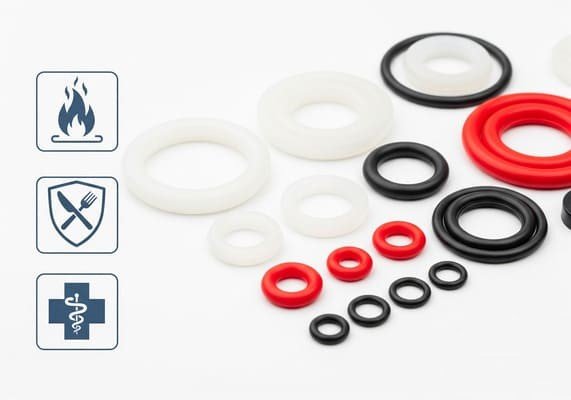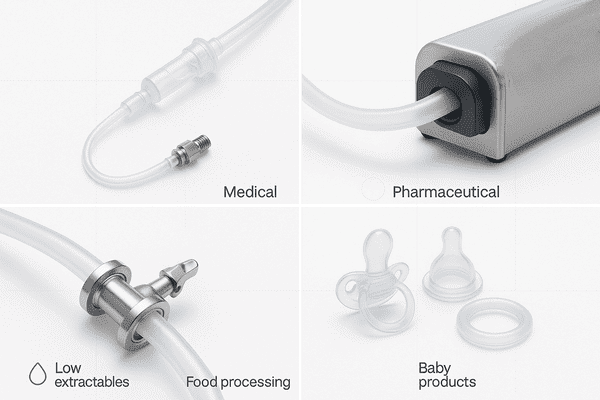Wrong gasket materials cause leaks, downtime, and recalls. I have seen this many times. FDA silicone rubber fixes the root problem: safe contact plus stable performance.
FDA silicone rubber meets 21 CFR 177.2600 extraction limits, resists heat and cleaning chemicals, and stays flexible. It reduces contamination risk, improves uptime, and supports audit-ready documentation for food plants.

I will explain what “FDA silicone” really means, how I choose hardness and temperature range, and how I verify compliance with simple documents that pass audits.
What does “FDA silicone rubber” actually mean?
Most buyers assume “FDA grade” is a certificate. It is not. It is a material and test requirement under the law.
FDA silicone rubber means a formulation that complies with 21 CFR 177.2600 and passes extraction tests in water and n-hexane. The supplier must keep traceable test reports for the exact compound and color.
I always write the regulation on drawings and POs. I avoid vague wording like “food safe.” I ask for a recent test report for the exact batch family. I keep that in the quality folder with the lot labels.
✅ Key facts I rely on
- 21 CFR 177.26001 defines extraction limits2 and test conditions.
- Compliance is material-specific, not factory-wide.
- Colorants and additives must also be compliant.
- Post-curing often improves results and odor.
🛠️ Mini checklist (copy and use)
- Write: “Material: Platinum-cured FDA silicone (VMQ), compliant with 21 CFR 177.2600.”
- Request: Recent extraction test for the same compound and color.
- Keep: Lot traceability from mixing to shipment.
- Confirm: Post-cure applied and time/temperature recorded.
Is FDA silicone rubber always safe for every food process?
Buyers ask me this every week. The short answer is no. Process conditions matter.
FDA compliance addresses composition and extraction. You must still check temperature, chemicals, abrasion, steam cycles, and cleanability. For harsh CIP/SIP, choose platinum-cured, post-cured silicone with the right hardness and design.

I once changed a client’s blue silicone gasket from 50 ShA to 70 ShA after repeated nicks during cleaning. The seal finally survived their spray balls and pump startup.
Typical risk sources I screen
- Over-temperature near heating elements
- Swelling from oils, flavors, or high-pH detergents
- Poor compression set3 after long holds
- Micro cuts from metal edges or misaligned clamps
How should I choose hardness, temperature, and compression set?
Wrong hardness causes leaks or damage. I pick hardness with clamp force and surface finish in mind.
Most food gaskets use 50–70 ShA. Temperature windows of −60 to +200 °C suit many lines. For repeated steam cycles, use high-consistency, platinum-cured silicone with tight compression-set specs.

Hardness vs typical use (my go-to guide)
| Hardness (ShA) | Typical Use | Why I choose it | Notes |
|---|---|---|---|
| 40–50 | Light clamp tri-clamp seals, lids | Easy compression | Watch extrusion at pressure spikes |
| 60 | General-purpose sanitary gaskets | Balance of seal and durability | My default for flat gaskets4 |
| 70 | Knife-edge flanges, CIP jets | Resists nicks and creep | Needs higher clamp force |
| 80+ | High-pressure valve seats5 | Better shape retention | Check DIN ISO 3302-1 tolerance ability |
Temperature and compression-set comparison
| Property | Standard FDA VMQ | Premium (Platinum, Post-Cure) |
|---|---|---|
| Working temp. | −50 to +200 °C | −60 to +220 °C (short +250 °C) |
| Compression set @ 175 °C/22 h | 35–45% | 15–25% |
| Odor/taste risk | Moderate | Very low |
| Typical color | Translucent, white, red | Translucent, blue, custom colors |
✅ I ask for compression set data at the real operating temperature. It predicts long-term seal force much better than hardness alone.
How do I verify FDA compliance6 before purchase?
Documents make or break audits. I prepare them before sampling, not after.
I request the test report for 21 CFR 177.2600 with compound ID, batch family, color, and date. I match it with a material data sheet, post-cure record, and a simple lot trace map.
My document pack that passes audits
- ✅ Compliance report: 21 CFR 177.2600 extraction, water + n-hexane
- ✅ Material data: VMQ grade, curing system, pigments, peroxide-free if needed
- ✅ Post-cure record: temperature and hours
- ✅ Certificate of compliance (COC) with lot and compound code
- ✅ Traceability: mixing → molding → inspection → packing
- ✅ Optional: USP Class VI7 (for high hygiene), WRAS for potable water if relevant
Common pitfalls I remove early
- A report for another color (different extraction)
- A report for a different compound code
- Missing post-cure information
- No lot label on bags and cartons
Does platinum-cured silicone always beat peroxide-cured for food?
This is the most common material question I receive. The answer is “often, but not always.”
Platinum-cured silicone usually has lower extractables, better clarity, and lower odor, which helps with taste-sensitive foods. Peroxide-cured silicone can work for non-critical contact if tested and post-cured well.

Side-by-side decision points
| Factor | Platinum-Cured | Peroxide-Cured |
|---|---|---|
| Extractables/odor | ✅ Lower | ⚠️ Higher without strong post-cure |
| Transparency | ✅ Clear/translucent | Opaque |
| High-temp stability | ✅ Very good | Good |
| Cost | Higher | Lower |
| Lead time | Sometimes longer | Often shorter |
| When I choose it | Taste/odor critical, CIP/SIP | Cost-sensitive, non-contact zones (guards, covers) |
I still demand 177.2600 tests for both systems if there is any food contact.
What gasket designs work best for hygienic cleaning (CIP/SIP)?
Design matters as much as material. I avoid dirt traps by design, not only by cleaning.
I use smooth radii, avoid sharp corners, and target 15–25% squeeze for flat gaskets. For tri-clamp seals, I pick profiles that drain. I color parts blue for visual detection.
Seal geometry rules I follow
- I keep continuous, closed profiles; no dead legs.
- I avoid over-squeeze that causes creep and cracking.
- I add lead-in chamfers to protect edges during assembly.
- I specify surface finish on mating metal to reduce micro-cuts.
- I choose blue or metal-detectable silicone when inspection needs it.
Compression targets and torque guide (reference)
| Joint Type | Squeeze Target | Notes |
|---|---|---|
| Flat gasket, rigid flange | 15–25% | Check bolt torque map |
| Tri-clamp sanitary | Profile-specific | Follow manufacturer table |
| Valve seat | Design-specific | Verify seat line pressure |
| Sight-glass seals | 15–20% | Avoid glass edge chipping |
Which standards and certificates should I ask for besides FDA?
Food plants often operate under mixed rules. I prepare both US and EU paths.
For the US, I anchor on 21 CFR 177.2600. For the EU, I reference Regulation (EC) 1935/2004 and applicable migration testing. Some buyers also request LFGB. I keep both sets when exporting globally.
Cross-region reference table
| Region | Primary Basis | Typical Evidence | When I include it |
|---|---|---|---|
| US | 21 CFR 177.2600 | Extraction report, COC | Always for US food contact |
| EU | 1935/2004 (+ testing) | Migration test summary | For EU-bound goods |
| Germany | LFGB8 | LFGB test report | Upon buyer request |
| Pharma/Med | USP Class VI | Class VI report | If line touches nutraceuticals |
| Water | WRAS | WRAS approval9 | Potable water lines |
I explain to buyers that “FDA compliant” is not an EU approval. I align early to avoid retesting after shipment.
Will FDA silicone rubber increase my cost or lead time?
It can, but planning helps. I manage cost and time by locking the compound early.
FDA platinum-cured silicone often costs more and needs post-cure time. I keep common hardnesses in stock molds, confirm color early, and approve samples with a simple PPAP to compress the timeline.
My scheduling map (typical custom parts)
- Tooling: 2–4 weeks (compression/transfer molds)
- Material lead: 1–2 weeks if standard color; +1 week for custom pigments
- Post-cure: 4–8 h typical; plan oven capacity
- First articles + tests: 1 week
- Production: 1–3 weeks depending on volume
Cost levers you control
- Use a standard hardness (50/60/70 ShA).
- Approve a standard color (translucent/blue/white).
- Reuse stock gasket profiles when possible.
- Batch orders to reduce post-cure cycles.
How do I avoid the most common failures on food lines?
My failure database points to the same causes over and over.
Most failures start with the wrong hardness, poor edge protection, and ignored compression set. I specify edges, finishes, and torque; I verify compression set; I train operators to replace gaskets on a schedule.
Root causes and quick fixes
| Root Cause | Symptom | Fix I implement |
|---|---|---|
| Over-squeeze | Early creep, leaks after shutdown | Torque spec and 15–25% squeeze |
| Under-squeeze | Drips at startup | Add shims or select softer hardness |
| Chemical attack | Swell, tacky surface | Review CIP chemistry and switch compound |
| Edge cuts | Nicks after cleaning | Add chamfers; harder grade; polish metal edges |
| Poor compression set | Leaks on day 3–5 | Premium platinum VMQ; verify CS data |
Conclusion
FDA silicone rubber protects food, uptime, and brand trust. I choose the right hardness, verify documents, and design for cleaning. That is how lines stay safe.
-
Understanding this regulation is crucial for ensuring compliance in food contact materials. ↩
-
Learn about extraction limits to ensure materials are safe for food contact. ↩
-
Understanding compression set helps in selecting the right materials for durability. ↩
-
Explore this resource to understand optimal designs and materials for flat gaskets, ensuring safety and compliance in food applications. ↩
-
Explore this resource to understand the optimal materials and designs for high-pressure valve seats, ensuring safety and efficiency in food processing. ↩
-
Understanding FDA compliance is essential for ensuring safety in food applications. ↩
-
Understanding USP Class VI is crucial for materials used in sensitive applications. ↩
-
Explore LFGB regulations to ensure compliance for products in the German market. ↩
-
Learn about WRAS approval to ensure materials are safe for drinking water applications. ↩








